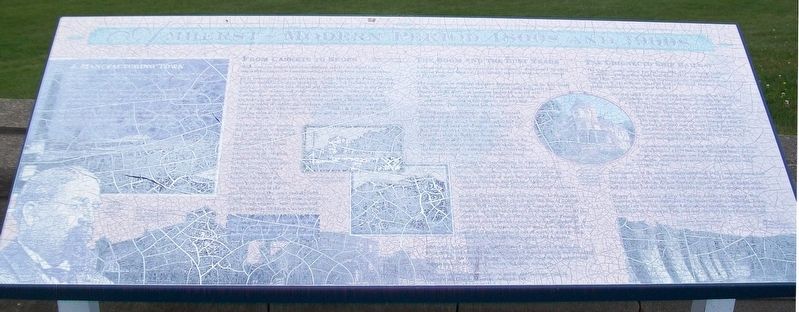Amherst – Modern Period 1800s and 1900s
A Manufacturing Town
All major roads and rail-lines run through Amherst, making it a natural gateway into Nova Scotia. The town is also in the middle of a rich agricultural and coal-mining area.
Amherst became a major manufacturing town in 1865 following the arrival of the Intercolonial Railway. Early industry was based on the exploration of nearby resources and was fueled by coal from the Springhill and Joggins coalfields.
By the end of the 19th century, primary manufacturing plants had opened their doors and Amherst was able to assume the mantle of the ‘Maritime’s most heavily industrialized town. For the next twenty years, it would serve as the barometer of industrial fortune in the region.
From Caskets to Shoes
With access to natural resources, Amherst quickly developed into a major industrial center manufacturing everything from caskets to shoes.
Early industrialists such as Alexander Robb, Matthew O. Pride, George, Charles and Alec Christie, Nelson [?] Rhodes, and Nathaniel Curry, were quick to exploit their vast mineral and timber reserves and in the process gain lucrative railway and public works contracts. Profits from these ventures were subsequently reinvested into their new factories: Robb Engineering, an iron foundry established in 1848, Christie [?] & Co., manufacturers of caskets
and carriages, established in 18[?], Amherst Boot & Shoes Co., which opened in 1867, Rhodes & Curry, a woodworking plant and rail car producer founded in 1877, and the Amherst Foundry began in 1850[?].Rhodes and Curry became the largest firm in Amherst. In 1901, it employed a tenth of the population in the manufacturing of house fixtures, and in the construction of complete housing developments, hotels, factories, and other large buildings. After a number of mergers it became, for a time, the largest producer of railway and refining cars in the country. During the same period, Robb Engineering gained a world wide reputation for its steam engines, water pumps and electric engines. Amherst was booming.
The Boom and the Bust Years
Amherst industries became successful in a relatively short period. In 1901 Amherst Boot and Shoe Co., for example, reported a twenty year output of $7,000,000.
The population of Amherst also grew dramatically. During the first decade of the 20th century, ninety new homes were being built each year. Despite a slight decline in fortunes, caused by a world wide slump in 1908, Amherst entered the second decade with its industries operating at full capacity and with high employment. This would not last, however.
In 1914 a general depression hit hard. Rampant unemployment followed. In the winter of 1915 conditions were so bad that
Following the war, industry in Amherst entered its final decline. Many items, such as pianos, railway cars, and stoves were either no longer in demand or were being produced more cheaply in Ontario and Quebec. Moreover, companies moved their bases of operations elsewhere.
In 1921 the economy hit rock bottom. In March the Malleable Iron Works closed with the loss of 200 jobs, a further 800 were laid off at the Canadian Car and Foundry and 200 at Amherst Boot and Shoe Co. At the same time, Robb Engineering and Amherst Foundry operated under partial capacity. By April, almost all of Amherst’s industries had been shut down. Between 1200 and 1500 men were now out of work. Forced to look elsewhere for work, many people left Amherst.
Although Amherst never again achieved its past level of industrial prosperity, reminders of the glory years of manufacturing and industrial prominence can forever be appreciated in the magnificent estates and mansions built by factory owners and their managers.
For more information on Amherst and its rich heritage, visit the Cumberland County Museum, Amherst, NS.
The Chignecto Ship Railway
The Chignecto ship railway was the brainchild of Henry George Ketchum. An ambitious concept that would have shortened the sea voyage from Saint John, New Brunswick to the Northumberland Strait by an estimated [500?] miles, it was to be the first of its kind in the world. However, after partial construction, it was never finished.
The plan called for an engineering marvel between Fort Lawrence and Tidnish. At each end of the route, hydraulic lifts would life a ship from a holding basin onto a specially constructed cradle. Hydraulic jacks, on the cradle, would keep the vessel upright. Depending on the vessel’s size, the 40 foot wide cradle would consist of one, two or three flatcars. The latter, it was estimated, could transport a ship 280[?] feet long and 3000 tons in weight. Each car had sixty four wheels that ran on two sets of parallel tracks. Two locomotives working in tandem (one on each track) would be engaged to pull the load.
Construction began in October 1888. Ketchum supervised proceedings on a daily basis. Four thousand men toiled on the project, among them new Italian emigrants and Scottish stonemasons employed to construct the docks and the bridge over the right of way.
Three quarters of the work had been completed. Docks were in place at both ends and a 500 feet long by 300 feet wide stone-lined basin had been constructed at Tidnish. Almost fourteen miles of 110-pound double track had also been laid and the special hydraulics and steam engines put in place.
Despite an expenditure of over 3.5 million dollars, the Chignecto Ship Railway was never completed and the dream remained unfulfilled. Today, visitors can view the remains of this unique marine engineering feat at Tidnish Dock Provincial Park and may also visit Henry Ketchum Trail.
[Image captions, from left to right, read]
• Amherst industrialist M. O. Pride
• (L-R) Amherst Boot & Shoe Co. Ltd., Christie Bros. Co. Ltd., Amherst Pianos Ltd.
• [The two overlapping middle image captions are illegible]
• One of the many luxurious homes that were built during Amherst’s boom years.
• Ship Railroad dock near Amherst.
• (Background) Amherst Post office.
Topics. This historical marker is listed in these topic lists: Industry & Commerce • Waterways & Vessels. A significant historical month for this entry is October 1888.
Location. 45° 51.177′ N, 64° 15.595′ W. Marker is near Fort Lawrence, Nova Scotia, in Cumberland County. Marker is 50 meters NNW of the Nova Scotia Welcome Centre. Touch for map. Marker is at or near this postal address: 90 Cumberland Loop, Fort Lawrence NS B4H 3Y5, Canada. Touch for directions.
Other nearby markers. At least 8 other markers are within 5 kilometers of this marker, measured as the crow flies. Fort Lawrence and English Settlement (here, next to this marker); Early Inhabitants (here, next to this marker); Natural History (here, next to this marker); Beaubassin (within shouting distance of this marker); Un hommage à/A Tribute to Jacob (Jacques) Bourgeois (within shouting distance of this marker); Beaubassin 1672-1750 (about 90 meters away, measured in a direct line); Trans Canada Highway (about 120 meters away in New Brunswick); Jonathan McCully (approx. 4.2 kilometers away). Touch for a list and map of all markers in Fort Lawrence.
More about this marker. The marker is heavily checkered from weathering and is difficult to read.
Also see . . .
1. Historic Amherst. (Submitted on January 1, 2018, by William Fischer, Jr. of Scranton, Pennsylvania.)
2. The General Strike in Amherst, Nova Scotia, 1919 (Nolan Reilly). (Submitted on January 1, 2018, by William Fischer, Jr. of Scranton, Pennsylvania.)
Credits. This page was last revised on January 1, 2018. It was originally submitted on January 1, 2018, by William Fischer, Jr. of Scranton, Pennsylvania. This page has been viewed 650 times since then and 87 times this year. Photos: 1. submitted on January 1, 2018, by William Fischer, Jr. of Scranton, Pennsylvania. 2. submitted on September 27, 2017, by William Fischer, Jr. of Scranton, Pennsylvania.

